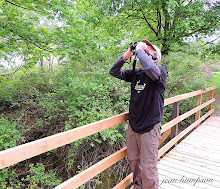The weekend arrived and unfortunately I had to work on the Saturday, leaving only one day to observe the grebe. On Sunday morning I checked the reports and the Western Grebe was observed at 8:00 AM. Perfect. Chances looked good for Jean and I to observe our second Western Grebe. Off we went to Saddington Park in Port Credit (Mississauga). Previous reports had the grebe moving between the west and east sides of the public park. When we arrived I could see two photographers and one birder with a scope at the west end of the park. They informed Jean and I that the bird was present and heading towards the barge and the Credit River at the east side of the park. We were also informed of another interesting species immediately west of the park.
The paved pathway provided easy access to the neighbouring cove and we had some great views of some waterfowl that are a very uncommon winter visitant (Bob Curry, Birds of Hamilton and Surrounding Areas). What duck could possibly have us momentarily setting a Western Grebe aside?

A Harlequin Duck (one male and two females)!

Not a lifer but a damn good addition to the year list.

Fulfilled with views of the trio of Harlequins, Jean and I moved on to catch a glimpse of the Western Grebe. The photographers were now located on the east side of the park. We joined them on the rocky pier at the mouth of the Credit River. Red-neck Grebes were spotted off-shore while we searched for the Western Grebe.

To the naked eye it appeared there was a bird between the barge and the marina but a view through the scope identified it as a piece of flotsam bobbing in the water. It really did look like a duck at first.

The long-necked grebe eventually presented itself but soon disappeared for what seemed an eternity. It could cover a great distance while underwater and we all scoured the lake with hopes of seeing it resurface within viewing distance of our bins and scopes. It popped up again near the retired barge and we were all able to view the Western Grebe.
Capturing a digiscoped image proved very difficult. Jean even thought the attempted shots only contained the waves of Lake Ontario but if you look closely at the image below, that nessie-like object in the bottom right hand corner is in fact the Western Grebe.

A cold wind blowing off the lake shortened our stay but we left Mississauga with not one but two rare additions to the year list.
Back in St. Catharines, we observed our first Turkey Vulture of the year.
It is now April and looking at last year's list we had already ticked an Eastern Meadowlark and Pied-billed Grebe before the end of March. They should fall into place rather easily but what I'm really hoping for is the return of two migrating species to the region. One being the Yellow-bellied Sapsucker that lays over in our neighbourhood for about two weeks and the other being Fox Sparrow. We have viewed Passerella iliaca every year (since 2007) while walking along Richardson's Creek. According to my lists, both these birds should soon be here.







Harlequin Duck - 3! you lucky dogs!- never seen one yet!Great birding coming up- can hardly wait ( actually I'm not!) practicing up for May!
ReplyDeleteHi Anne, I noticed that the Harlequin has allowed Jean and I to stay one species ahead of you and your sister on eBird's Ontario Top 100. Glad to see you were able to move up the ladder.
ReplyDeleteYes, we can't wait for May either. Hopefully our visits to Malcolsom Eco Park in St. Kitts will produce a lifer warbler.